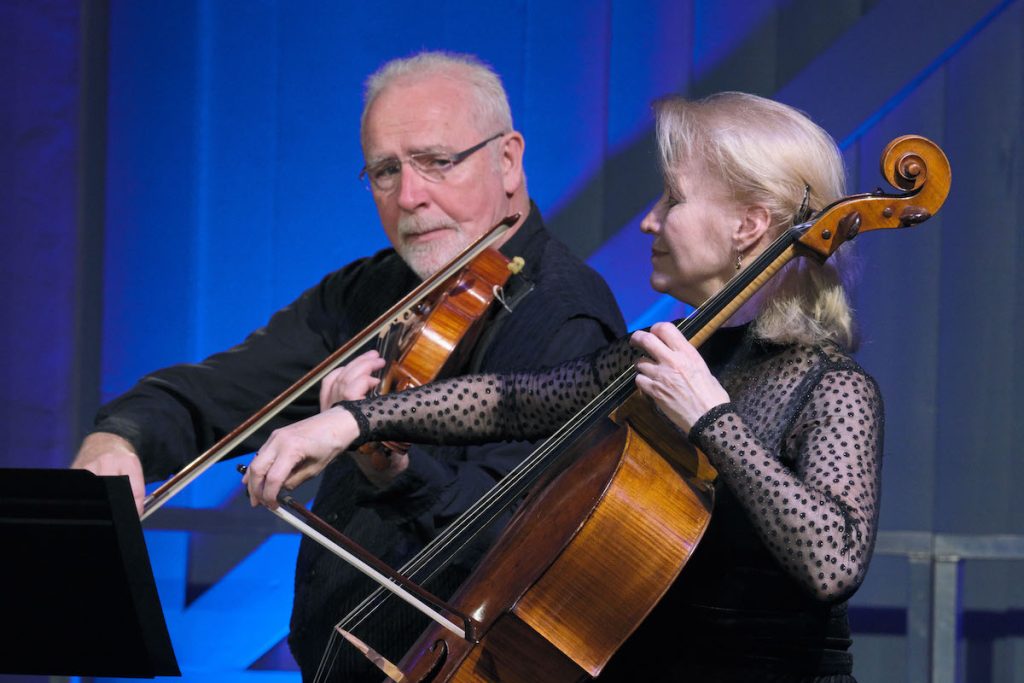Playing together for the first time, Bill Barton and Britain’s Brodskys brought their A-game to a B-themed program.
S. Bach, William Barton and the Brodsky Quartet. All three begin with a ‘B’ but they are hardly B-players. Sunday night’s concert was a vindication of the musicians’ talent, and a historic occasion. It was the first time Barton – the multitalented First Nations didgeridoo player, vocalist and composer – and the British string quartet had performed together, and the belated world première of a powerful work by Andrew Ford.
The Brodskys mark their 50th anniversary this year – two of the original musicians are still with the group – and their playing was as polished and impeccable as one would expect. Barton is an astonishing performer; playing the didgeridoo, his breath control is breathtaking.
The Brodskys began, beguilingly, with Bach: his Violin Sonata No. 1 in G minor, BWV 1001 (1720), originally a solo piece, arranged for the quartet by the Brodskys’ violinist, Paul Cassidy. Bach would have delighted in the ingenious counterpoint, his original line multiplied by four. Cerebral, dignified but warm, sweetly melancholy, it was a contemplative start to the evening, and set the tone for the next two works.
Next came William Barton’s Square Circles Beneath the Red Desert Sand(2017), which evokes the spirits of his Mt Isa–Kalkadunga country.
The opening of the piece is improvised. As the string quartet plays a droning series of chords, a voice comes from the back of the hall, and slowly advances. It is Barton. His singing is somewhere between Gregorian chant and Led Zeppelin’s Kashmir, inexpressibly ancient and hieratic. From deserts, prophets come, I was reminded.
Barton has written that the piece brings together Australian and classical Western cultures through the combination of the didgeridoo, “one of the oldest instruments of Australia and perhaps the world”, and the violin, viola, and cello. Strings seem to shimmer like heat haze in the desert, while the didgeridoo pours out strange rhythms and birdsong. The effect is mesmerising.
The crowd loved it: they erupted in shouts and cheers, and a torrent of sustained applause. (Barton will perform this piece in Canberra again later this year: it will open the Canberra Symphony Orchestra’s June concert, Red Desert Sand.)

Ford’s String Quartet No. 7: Eden Ablaze was written as reportage during the 2019–20 Black Summer bushfires. Ford and his family were evacuated from their Southern Highlands home, and the composer intended the piece as a bulletin from the front line, he explained. But it had to wait three years for its premiere.
Ford composed the piece in January and February 2020, and it was scheduled to be performed in Bristol in April of that year, when the Brodsky Quartet and Barton were to have appeared together. Ford made the last edits to his score on 8 March. Three days later, the World Health Organisation declared the COVID-19 outbreak was a world pandemic. “And, of course, the concert didn’t happen,” Ford told the audience.
The title, Ford explains, refers to both the town of Eden and the prehistoric Gondwana rainforests of northern NSW and southern Queensland, a “living link with the vegetation of [the southern continent] Gondwanaland in the Jurassic age, 180 million years ago”.
Half those ancient forests were burnt in the bushfires. “It felt oddly like a loss of innocence, though in truth it was probably more serious than that.”
The stage was red-lit, evoking those grim days of flames and sulphurous skies. The piece begins with a didgeridoo prelude, played by Barton. The strings play “Ombra mai fu” from Handel’s opera Serse, the Persian king’s aria to a plane tree, grateful for its shade. Slowed down here, it becomes a dirge, an astringent countermelody flickering through Handel’s tune.
When the Fords returned home, “we found a place that was eerily still and shrouded in fog and smoke,” the composer said. “About the only movement was specks of ash gently falling from the sky.” The piece ends with a musical depiction of that ash. The music becomes increasingly rough and discordant: pizzicato string plucking, jagged phrases, and fluttering descending figures over a sustained high note almost at the edge of hearing.
The didgeridoo returns at the end as a ghostly presence, puffs and wisps of wind grow in intensity, then the music fades out, quietly. It is a sombre piece, and a moving reflection on loss.
The second half of the concert, after the interval, consisted of Schubert’s String Quartet in G major, D.887. Much has been made of its length, more than three-quarters of an hour.
The scale of the piece broke the boundaries of what string quartets could do, the Brodskys’ violinist, Krysia Osostowicz said; it is as much symphony as string quartet. That length can be daunting – music critic Harry Haskell notes that the work “demands considerable stamina from both listeners and players”, while Osostowicz joked that the last movement, an enormous tarantella, is the equivalent of Stravinsky’s Rite of Spring: “The Chosen One has to dance herself to death … That’s what we have to do!”
But neither the quartet nor the audience showed signs of fatigue. The Brodskys played almost as one four-headed individual, long years of performing together having formed them into a gestalt entity, while my companion remarked that the work flashed by in the blink of an eye. The melodies from the spirited Scherzo danced in my head for hours afterwards.
Feature image: The Brodsky Quartet and William Barton, Canberra International Music Festival. Photo © Peter Hislop
This review was originally written and published by NICK FULLER from LIMELIGHT on 30 April 2023.
